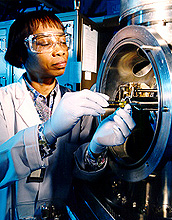News Release 06-147
NSF Report Reveals Century of Doctoral Education Trends in the United States
Last 25 years of the 20th century showed largest period of growth and diversity

A growing number of women and foreign nationals pursued U.S. doctorates in the 20th century.
October 10, 2006
This material is available primarily for archival purposes. Telephone numbers or other contact information may be out of date; please see current contact information at media contacts.
A new report released by the National Science Foundation (NSF) documents trends and patterns that reveal the rapid growth and changing demographics of doctoral education during the 20th century, especially over the last 25 years.
U.S. Doctorates in the 20th Century reveals many factors about who is educated and where. It also describes the complex changes taking place in the pursuit of doctoral degrees, many in new interdisciplinary fields. For example, relatively small Oberlin College in Ohio provided the baccalaureate origins of more science and engineering doctorates over an 80-year period (nearly 2,800) than the University of Nebraska, Duke University, Johns Hopkins University, Virginia Tech and the University of Iowa. Another example is that five of the eight leading doctorate-granting universities from 1920-1999 were Midwest-based, Big Ten schools. Prior to that period, the majority of doctorate-granting institutions were East Coast institutions.
"The report shows how much has changed in doctoral education in just 25 years," says Susan T. Hill, director of the Doctorate Data Project in NSF's Division of Science Resources Statistics. "For one thing, nearly two-thirds of all doctorates awarded in this country occurred in the last 25 years of the 20th century. Second, the United States has become an educator of the world, expanding its role in providing doctorates to foreign-born and U.S. students. Third, the U.S. system reveals a great flexibility in opening varied pathways for Ph.D. recipients into career opportunities both in and outside their fields. This has increased U.S. innovation, competitiveness and leadership in many fields."
The report is based on the Survey of Earned Doctorates, which had a 95 percent response rate. Some of the report's major findings include:
Changes in demographics
- Men received 73 percent of all doctorates awarded in the 20th century, but in the 1990s, women made significant gains, receiving over 40 percent of all doctorates.
- Foreign nationals held less than 10 percent of all doctorates before 1960 but received more than a third of all science and engineering (S&E) doctorates by 1999, and 17 percent of non-S&E doctorates.
New pathways to doctoral degrees
- Two-year colleges vastly increased their role in educating those who go on to pursue a Ph.D. In the century's final 5 years, 1995-1999, one-fifth of all American Indians/Alaska Natives who received doctorates attended two-year colleges. One-sixth of all Hispanic Ph.D. recipients also reported having attended two-year colleges.
- From 1995-1999, almost a third of African-American Ph.D. recipients reported receiving an undergraduate degree from a Historically Black College or University (HBCU).
Increasing Indebtedness
- In 1999, for the first time, more than half of all graduating doctorates reported debt from their undergraduate and graduate education.
- In non-S&E fields, doctorates owing more than $20,000 from education loans quadrupled between the late 1980s and late 1990s. The corresponding percentage for science and engineering doctorates owing more than $20,000 was also significant, more than doubling during the same period.
"The report is an essential reference for understanding how the nation's educational system evolved. It's an indispensable starting point for those who plan the next steps we take in this remarkable enterprise," Hill says. "The increasing reliance on loans to support doctoral study is a trend we should follow as students from lower income groups make decisions on whether or not to seek advanced degrees."
U.S. Doctorates in the 20th Century was produced under an NSF contract with SRI International and authored by Lori Thurgood, Mary J. Golladay (NSF), and Susan T. Hill (NSF). NSF provided funding for the report, along with the National Institutes of Health, National Endowment for the Humanities, NASA, the Department of Education and the Department of Agriculture.
To view the NSF report, U.S. Doctorates in the 20th Century , see: http://www.nsf.gov/statistics/nsf06319/.
For more information, see:
http://www.nsf.gov/statistics/new.cfm
http://www.nsf.gov/statistics/doctorates/
-NSF-
Media Contacts
Dana Topousis, National Science Foundation, (703) 292-7750, email: dtopousi@nsf.gov
Program Contacts
Susan T. Hill, National Science Foundation, (703) 292-7790, email: sthill@nsf.gov
The U.S. National Science Foundation propels the nation forward by advancing fundamental research in all fields of science and engineering. NSF supports research and people by providing facilities, instruments and funding to support their ingenuity and sustain the U.S. as a global leader in research and innovation. With a fiscal year 2023 budget of $9.5 billion, NSF funds reach all 50 states through grants to nearly 2,000 colleges, universities and institutions. Each year, NSF receives more than 40,000 competitive proposals and makes about 11,000 new awards. Those awards include support for cooperative research with industry, Arctic and Antarctic research and operations, and U.S. participation in international scientific efforts.
Connect with us online
NSF website: nsf.gov
NSF News: nsf.gov/news
For News Media: nsf.gov/news/newsroom
Statistics: nsf.gov/statistics/
Awards database: nsf.gov/awardsearch/
Follow us on social
Twitter: twitter.com/NSF
Facebook: facebook.com/US.NSF
Instagram: instagram.com/nsfgov
